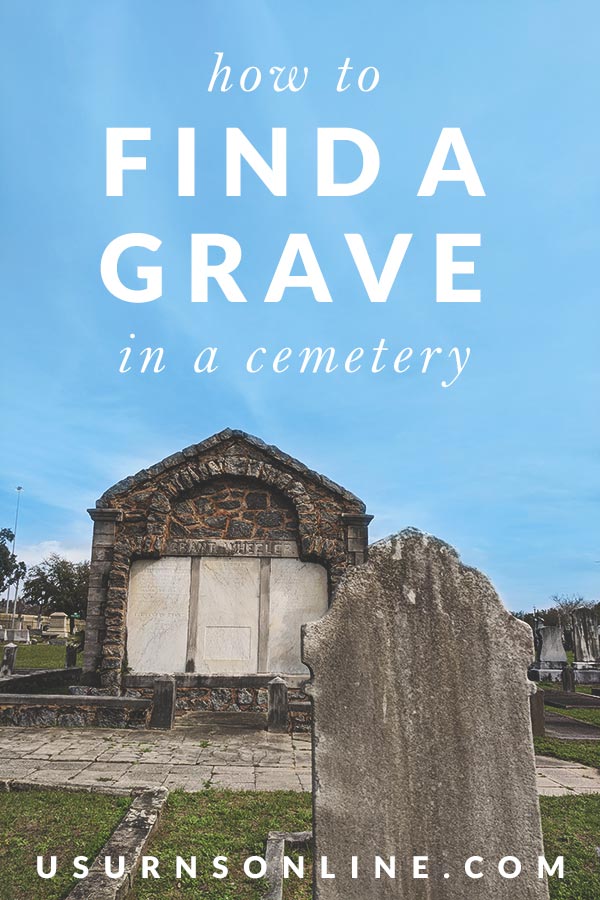How do you find a grave in a cemetery?
Sometimes in life, we have occasion to locate the headstone of a loved one or an ancestor we’ve never even met.
Today we’re going to dive into this relatively unusual but pertinent endeavor. If you’re starting from square 1, this can be a daunting task. Especially with older cemeteries, or ones not attached to an active funeral home.
In this article we provide what you need to know to find a specific grave, headstone, or final resting place.
But first let’s take a look at why you might be trying to find a grave.
Reasons for Finding a Grave in a Cemetery
Here are some of the more common reasons people want to locate a grave in a cemetery:
- Paying respects to a loved one.
- Looking to buy a burial plot for yourself or a family member close to that of a loved one.
- Planning to hold a memorial service for a loved one who’s already passed.
- Researching your own ancestry.
No matter your personal reason for locating a grave, we hope the information you find here will serve as a helpful starting point.
How to Find a Grave in a Cemetery: 8 Tips
Here are eight tips to help you find a grave. We’re going to start from the very beginning and assume you don’t even know at which cemetery the grave is located.
But even if you do know the cemetery, you’ll still need several of these tips so you can narrow it down to the specific plot or section of the cemetery. So read through carefully, and we wish you the best!
Tip 1 – Gather Basic Information
It doesn’t matter whether you already have some details or are “starting from 0”; the first and most important step you can take in finding a grave in a cemetery is to gather as much information as possible.
Urns Made in the USA
Data that will be helpful in your search includes:
- Decedent’s full name
- Dates of birth and death
- Location of birth and death
- The funeral home that carried out their burial
Tip 2 – Get Online
Even if you’re only going off a name, perhaps the easiest way to begin your search is to sit down at your computer or swipe out your phone. The internet is chock-full of ancestry (including cemetery-related) information. Much of it is in the public domain, making it that much easier to garner details.
Sometimes, all you need to do is a simple Google search to find a grave. Simply input the name of your loved one into the search engine and hit enter. Their grave site may already be recorded in a database on a website such as Ancestry, and it will pop right up in the search results.
Other times you can input the name into a helpful website database, like those found at Find a Grave and Billion Graves.
If you know your ancestor was in the military, you may also have luck searching the National Cemetery Administration’s database; they could very well be buried in a National Cemetery.
Tip 3 – Interview Family Members
It’s astounding to think about, but you may have an entire treasure trove of ancestral information that’s only a phone call away.
That treasure trove? Grandma and Grandpa’s memories.
There is so much information regarding family history that only the elders in our lives possess. And when they pass away, they’re going to take it all with them.
So while you have the time, give them a call today or arrange a sit-down interview with them to find out all you can about the person whose grave you’re trying to find. Chances are, they may already know, and can also provide even more interesting information.
Ask them if it’s okay to record your conversation on your phone. It may be more convenient than a pen and pad, AND you’ll have your elders’ voice recorded for prosperity.
A few months before my husband’s grandfather died, the family sat around him with a recorder and he shared information about his family, childhood, and so much more. It’s a highly informative and lasting treasure to his children and grandchildren.
Tip 4 – Get in Touch with the Funeral Home/Cemetery
It should go without saying, but if you need to find a grave in a certain cemetery, it’s a good idea to contact that cemetery directly. You can also pay a visit to the funeral home that directed your loved one’s funeral and burial; they should have the information on file.
Will you be visiting a National Cemetery? There may be a Information Center on the grounds, or even an electronic kiosk at which you can search for your loved one’s name and final resting place.
Interestingly enough, if you’re searching for a famous (or infamous) person’s grave, many funeral homes and cemeteries will not readily hand out that information. For example, it’s public information that President Kennedy’s assassin, Lee Harvey Oswald, is buried at Shannon-Rose Hill Cemetery in Fort Worth. But funeral home employees will not reveal the exact location of his grave.
Tip 5 – Seek Help from the County Clerk
Local county clerks’ offices keep vital statistics, including birth certificates, marriage licenses, divorce decrees and death certificates. Do you know the county in which your ancestor was born, married, or died? These documents may offer clues as to where they are buried.
Many counties maintain a log of these statistics online. But some will require proof that you are family, or next-of-kin, to the deceased before they will release records.
Tip 6 – Research Church Records
Long before the Internet came along, and even before governments began collecting data, the church was the heart of family record keeping. Most churches, no matter the denomination, kept rigorous records of marriages, births, christenings and baptisms, deaths, and burial information.
So if you can’t locate any information regarding a specific grave for a specific person, especially if they died a long time ago, a church from around the area in which they used to live may be a helpful resource. Traditionally, the sexton (the person whose job it is to maintain a churchyard) would be the one you’d want to speak to, especially if you’ll be searching a parish cemetery.
Read More: What is a Cemetery Sexton?
Bonus Tip
My granddad was big into genealogy, a passion that I inherited from him. He once shared with us a little-known secret to finding graves and other ancestral information: the Mormon Church.
The Church of Jesus Christ of Latter-day Saints maintains a vast trove of family records, of both Mormons and non-Mormons. They have kept such records since the early 1900s, out of their belief in the baptism of the dead. While my granddad had to physically visit a local LDS Church to find out more about his own family (he began researching before the advent of the Internet), you can now access records through the Church’s online collection, FamilySearch.
Tip 7 – Research Newspaper Archives
Physical newspapers are becoming a thing of the past as virtually everyone gets their news online these days. But especially in the days before the telephone, it used to be that everyone got their information from the paper. Such information included announcements of local births, marriages, and deaths.
These days funeral homes will publish an obituary online, and that person’s family can then share it on social media. But back in the day, it used to be the obituary page in the newspaper that announced community deaths. Details such as date of death, cause of death, date and location of the funeral service would all be included in the blurb.
So if you can get your hands on an old newspaper or a copy of one, more power to you!
Do you already know your ancestor’s date and location of death? Then you have a good chance of finding their obit and consequently their place of interment.
Newspaper archives can be found and browsed through at your local library, as well as online through sites like Newspaper.com.
Tip 8 – Take a Walk Through the Cemetery
When all else fails, and all you have is the location to go by… it’s time to take a walk through the cemetery.
All you’ll need is some water, maybe a snack or two, and a whole lot of gumption.
If you think this can’t be done, think again. When I worked at a small town funeral home a few years ago, a family needed help finding the grave of an ancestor in an old cemetery nearby (where next to him would be buried their loved one who’d just passed away).
There were no other clues save for a few landmarks they could remember from decades ago. So I walked the ENTIRE cemetery looking for the plot. It took about two hours, but I finally found the headstone.
Was it a feasible task? No. But was it a viable last resort? Absolutely. And it was a really good feeling when I finally found the grave.
What to Do When You’ve Found the Grave
With this information under your belt, we hope you now feel better equipped to embark upon the journey of finding your ancestor/loved one’s final resting place.
Once you’ve found it… then what?
Depending on what your purpose and goals are, that’s up to you. But we would suggest:
- Take a photo (or several) of the grave. Take closeups of the headstone so you can read the inscription later if needed, and be sure to back off a ways and take a few snaps to give you landmarks to you can locate it again in the future.
- Write down the information. Copy the details on the headstone. Also note down where you found the burial location, and how to find it again.
- Look at nearby graves. Sometimes you’ll be surprised… maybe you’ll find another relative, such as a spouse, parent, sibling, child, or any number of near or far relations. If you’re looking into your family’s ancestry, note down the full names and dates from the nearby graves in case you run across those in future searches.
- Leave some flowers or a coin. These are two common ways to honor the memory of a departed person. Every life is unique and beautiful and deserves our respect. A simple gesture of leaving a flower (or even just pulling some weeds and cleaning up the area around the headstone a bit) is a good way to do this.
Have you ever had success finding a grave? Please let us know how it went in a comment below – we’d love to hear about it!
And be sure to check out these related links for further reading:
- 13 Questions to Ask When Choosing a Cemetery
- 10 Things NOT to Do in a Cemetery
- How to Decorate a Grave
- Ways to Create a Memorial Away from the Cemetery





